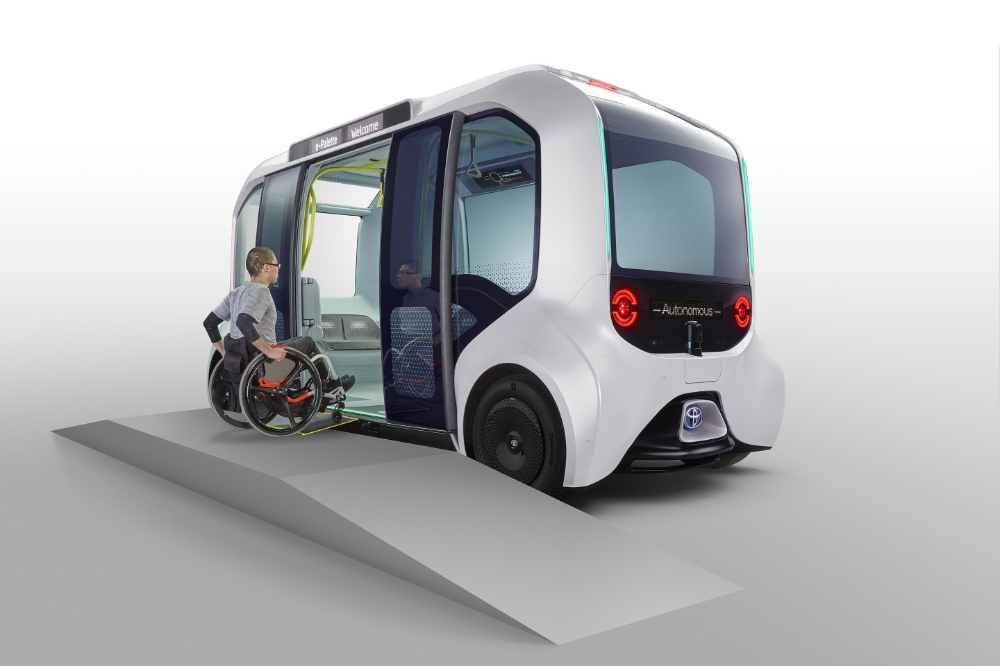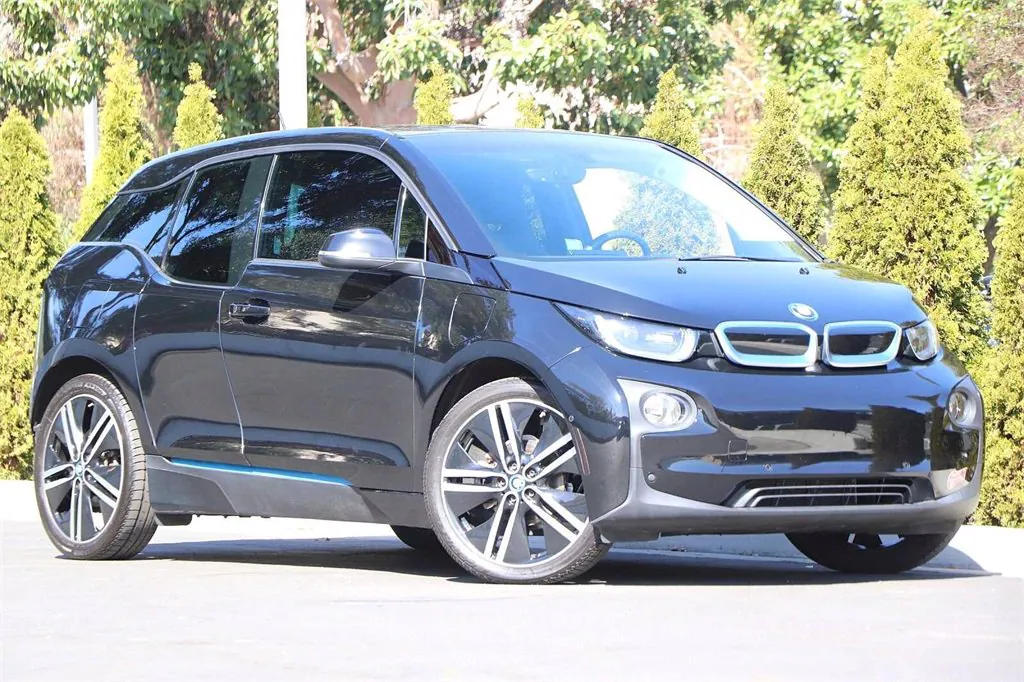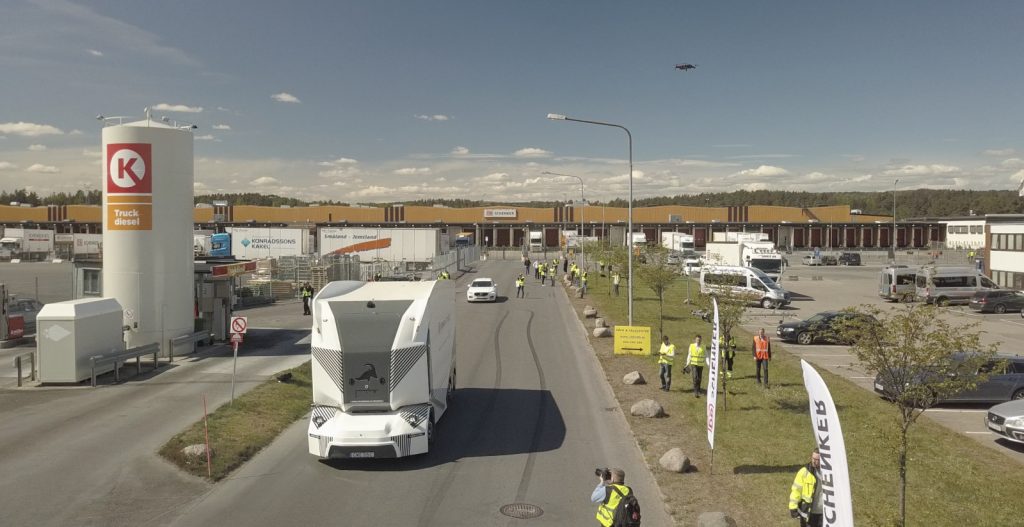
I have tried to approach Toyota neutrally, as a vehicle brand, over the past fifty years, but it has gradually sunk in my esteem. Today, it is probably the vehicle brand that I regard most negatively. Toyota’s major concern is that a rapid shift from ICE vehicles to EVs could erode its market share and reduce or eliminate profits.
Earlier, in our car purchasing careers, Patricia and I would attempt to evaluate Toyotas. However, they were not designed for our collective anatomies. If Patricia felt comfortable driving a model, it was uncomfortable for me, and vice versa.
Indeed, with the latest incident with their e-Palette pod at the Paralympics in Tokyo, Toyota is now permanently removed from my list of vehicle brands to consider purchasing.
The Last Straw
Toyota suspended use of the e-Palette transportation pods at the Tokyo Paralympic Games village, a day after one of the vehicles collided with and injured a pedestrian on 2021-08-26. After a couple of days the vehicles were taken into use again. The incident happened when a pod was manually controlled by one of its two on-board operators using the vehicle’s joystick. It pulled away from a T-junction and drove through a pedestrian crossing while Aramitsu Kitazono (1991 – ), a visually impaired athlete, was walking across. The vehicle operators were aware that a person was there but thought the person would realize that a bus was coming and stop crossing the street.
This situation involves a vehicle capable of autonomous operation, but being operated in manual mode. Thus, the statement made by Toyota CEO Akio Toyoda (1956 – ) is disingenuous, when he states that the crash shows autonomous vehicles are not yet realistic for normal roads. Indeed, all it shows is that human vehicle operation still results in accidents. Admittedly, there is a need to scrutinize the various levels of autonomous driving systems, including their safety and real-world capabilities. Such an incident is inconsistent with what is expected from a self-driving vehicle. A car cannot expect anything from a human being. It is the vehicle that must exercise caution.
This statement by Toyoda is the proverbial last straw. Toyota has opposed a fast transition to electric vehicles (EVs), something that appears critical to mitigate climate change. In 2021-06, several media sources reported that Chris Reynolds (1963 – ), an American Toyota executive with responsibility for government relations, travelled to Washington DC for closed-door meetings with congressional staff members. Here, he allegedly stated Toyota’s opposition to an aggressive transition to all-electric cars, arguing that internal combustion engine (ICE) – electric hybrids and hydrogen-powered vehicles should be accorded a bigger role.
Toyota has opposed stricter vehicle emission standards and electric vehicle mandates in North America, the European Union and elsewhere, including India, where Toyota’s Indian subsidiary publicly criticised India’s 100% electric vehicle sale target by 2030.
Toyota, and other legacy auto-makers, agreed with the Trump administration in a confrontation with California over the Clean Air Act. Toyota also sued Mexico over fuel-efficiency rules. In Japan, it argued against carbon taxes. Toyota concentrated on the wrong technology. Hydrogen fuel cells offer a costlier and, increasingly, a less developed technology in relation to battery EVs.
The Colours of Hydrogen
Hydrogen may be a colourless gas, but it is available in a variety of colours, based on how it is manufactured. Some methods are environmentally suitable, many are not, and there is no easy way to distinguish what is in any particular vehicle’s tank. This is a major problem for Toyota, when they attempt to promote hydrogen as an environmentally friendly product.
Black or brown hydrogen, uses black (bituminous) or brown (lignite) coal in the hydrogen-making process. Grey hydrogen is the most common form and is generated from natural gas/ methane, through steam reforming. With blue hydrogen, the carbon generated from steam reforming is captured and stored underground through industrial carbon capture and storage (CCS). It is, therefore, sometimes referred to as carbon neutral as the emissions are not dispersed in the atmosphere. However, it is probably more correct to regard it as low carbon because 10-20% of the generated carbon cannot be captured. In addition, storing the carbon can be problematic.
Green hydrogen is produced using clean energy from surplus renewable energy sources, such as solar or wind power, through electrolysis. Yellow hydrogen has two divergent meanings. It can refer to hydrogen electrolysis using solar power, or it can refer to electrolysis using mixed sources, including non-renewables, depending on what is available. Personally, I am attempting to refer to the latter as orange (up to 50% non-renewables) and red, when the non-renewables exceed this value. Pink hydrogen uses electrolysis powered by nuclear energy. Turquoise hydrogen may be more climate friendly than blue hydrogen, but it still relies on a fossil fuel, methane. It is currently an experimental process that uses methane pyrolysis to generates solid carbon. There is no need for CCS, and the carbon can be used in other processes, including tire manufacturing. I dislike the term turquoise being used in this way, because it greenwashes methane. Personally, I would like to refer to this as purple hydrogen.
Hybrids
Ferdinand Porsche (1875 – 1951) developed the Lohner-Porsche hybrid vehicle in 1901. It was the first hybrid. Yet, it is Toyota that is known for its hybrids. Hybrid electric vehicles become widely available with the release of the Toyota Prius in 1997. Since then, Toyota has stagnated. Despite the first plug-in hybrid car being built by Andrew Alfonso Frank (ca. 1934 – ), and his students, in 1971, the first mass produced plug-in hybrid passenger car was the Chinese BYD F3DM, launched in 2008. Before this, there were some experimental vehicles, including some Prius models, that were after-market plug-in hybrid conversions, but this was more despite Toyota, than because of Toyota. These added plug-in charging and additional lead-acid batteries, to extend range. It is not Toyota, but Mitsubishi, with its Outlander PHEV that is the world’s all-time best-selling plug-in hybrid. Hybrid vehicles require a duplication of technology, and do not offer any guaranteed reduction in fossil fuel consumption.
Politics
On 2020-12-07, Toyota announced plans to bring two EVs and a hybrid to the European market. On 2021-02-10, they repeated this for the US market. One of the EVs is the bZ4X SUV (and its badge engineered Subaru Solterra AWD). The others are more difficult to guess, but some sources think the plug-in could be a Toyota RAV4/ Subaru Forester. These EVs will not be built by Toyota, but by BYD, the Chinese EV manufacturer. Admittedly, plug-in hybrids can be efficient in some use cases, but it is an exaggeration, if not an outright untruth, to state, as Toyota did, that: “GHG [greenhouse gas contribution] of a currently available BEV model and PHEV model are roughly the same in on-road performance when factoring in pollutants created by electricity production for the average U.S. energy grid used to charge batteries.”
Toyota announced on 2021-09-08, that it is investing ¥ 1.5 trillion = ca. US$ 13.6 billion = ca. € 11.5 billion, in EV batteries as it is trying to catch up after falling behind in electrification. Masahiko Maeda (1969 – ), Toyota’s chief technology office, said that Toyota wants to secure 200 GWh of batteries by 2030. With an average battery pack of 60 kWh, this would be enough to produce more than 3 million EVs per year.
Toyota seems to be trying to game climate change, rather than taking it seriously. They are playing both sides: offering climate scepticism to climate sceptics and climate concern to environmentalists, when it suits them. My personal conclusion is that this approach makes Toyota one of the least ethical auto-makers in the world. It is attempting to undermine agreed upon climate goals, which may in themselves be too little, too late. Consumers with the possibility, should only be considering EVs for their next vehicle purchase. One approach is to retain a current ICE vehicle, until EV prices decline sufficiently to allow a purchase. Regardless, consumers should avoid buying Toyotas, until the company starts talking realistically about environmental concerns including human induced climate change, and shows real environmental progress by eliminating ICE (including hybrid) vehicles from their model program.
If not a Toyota, what?
In the coming months and years, a number of new, lower cost mass market EVs will be emerging, that are more reliable, economical and environmentally friendly than current vehicles. These will not be technological experiments on wheels, but functional mass-market products. The handling of fires in Chevrolet Bolts and Hyundai Konas, shows that manufacturing and selling EVs is not a game, but an endeavour with potentially serious and expensive consequences. While General Motors used delay tactics and let consumers deal with emerging safety issues, Hyundai replaced defective batteries almost immediately, despite the enormous cost. Now, General motors is also having to replace batteries at the same enormous cost, but has lost the respect and confidence of consumers. My expectation is that few consumers will want to prioritize buying a Bolt (or any other Chevrolet EV) in the future.
While there are several theories about innovation, one of the first and most influential was Everett Rogers’ (1931 – 2004) famous Diffusion of Innovations (1961) book, containing a model and curve (see below). Geoffry Moore (1946 – ) in Crossing the Chasm: Marketing and Selling High-Tech Products to Mainstream Customers (1991) regarded the step from early adapters to early majority as a chasm. Crossing it is difficult, yet critical for success. To understand why I am pessimistic about the fate of legacy auto-makers, one has only to read Clayton Christensen (1952 – 2020), The Innovator’s Dilemma (1997). He is not optimistic about the chances of any legacy manufacturer of anything surviving, in a disrupted market.

For the past ten years, EV models have been released that have suited initiators, innovators and early adopters, with an emphasis on sportiness and luxury. These values are wasted on the majority, who want pragmatic solutions to their transportation needs. In Norway, the early majority are already in the marketplace. By 2025, the late majority will have started buying EVs. Laggards will be making EV purchases by 2030, if not 2027.
Today, I read in passing that there are 138 EV models available. I don’t know how accurate this is, but it seems a reasonable approximation. I will make no attempt to influence or micromanage any reader, or to suggest any of these models for anyone. Instead, I will allow readers to see some of my considerations, when I evaluate EVs, and why I need help to make sensible choices. At the most basic level, safety (including positive crash test results) must be in place, and the technology (battery, motor, charging) must be sound.
I am not known for my wise automotive purchases. In part, this is because practicality has to combine with my personal sense of style (some would say, frivolity) to create an attractive vehicle. My first car was a 1962 Hillman Minx convertible, purchased in 1966. It was fun, but unreliable. It lasted six months. Together with Patricia, over our lifetimes, we have owned 2 English, 2 French, 2 German, 2 Japanese and 1 Korean vehicles. In this time I have learned something about vehicles, my own personality, and Patricia’s.
My temperament attracts me to utilitarian French vehicles because of their comfort, ground clearance and load carrying capacity, and despite their notorious lack of reliability. Yet, I manage to see them possessing utilitarian elegance. I have appreciated the Citroën Berlingo since its inception, but I am less enthusiastic about its current and upcoming electric Multispace, its multi-purpose vehicle (MPV) variants. Even the new Renault Kangoo ZE update in the same segment, is not being built as an EV from the ground up. However, I find Renault (and its sub-brand Dacia) along with Fiat, the most interesting European automotive manufacturers, precisely because there is a sense of whimsy in their design. What they lack in quality, they make up in style. Fiat, back in 2018, announced a 500 Giardiniera station wagon. Then in 2019, it presented the Centoventi (120) concept, which they suggested, could become the first Panda EV. Both would be built on an electric only platform. Both hold a design appeal I find lacking in a BMW or Cadillac or a Ford F-150. The main difference between 2019 and now, is that Fiat has become part of Stellantis, headquartered in Amsterdam, but with 30 manufacturing facilities around the world. Most new Fiat products would be built on the Stellantis STLA Small EV platform.
Fortunately, Patricia won’t let me make the most ruinous decisions, and tempers my desire for fashion, form, frivolity and fun. She will undoubtedly tell me that it would be much more sensible to purchase a Hyundai, such as the upcoming Ioniq 3 (compact) or Ioniq 1 (mini) crossover SUV EVs, but that I should wait until 2025, when more mass-market models will be available, at lower prices. Nirvana is less than 40 months away!
Regardless of what happens, it should be noted that I will not be the first in the family to own an EV. My daughter, Shelagh together with her husband, Derek, own a BMW i3.

Note: This post has been modified to include Shelagh and Derek’s change of marital status on 2022-11-22.


